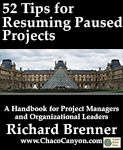You face a Skip to the Details:
How To Ordercritical decision. Bookings are up,
costs are down. Business looks like it's improving, and prices of critical technologies have
fallen. That big project you cancelled in 2002 is still a good idea, and you still want to
do it. But should you start from scratch or is there a way to pick up where you left off?
Tough questions.
 Here are just
a few of the issues:
Here are just
a few of the issues:
- How much would it cost to start from scratch? How much to resume?
- How do we get the team back together now that they've scattered to the four winds?
- What do we do about the political questions? How do we win over the people who got it cancelled back in 2004?
As the manager of a resuming project, or as someone who'd like to resume a cancelled or paused project, you face problems that differ markedly from the more familiar problems of a startup project, or even a continuing project. You must master the politics of resuming a project, of course, but that isn't enough. Once you get underway you'll face problems that you'll never see in a startup or continuation.
For example, if the project was formally cancelled, many of its assets, both human and not, have scattered. Putting them back together again can be a costly endeavor, entailing risks that a startup project or a continuing project never faces.
52 Tips for Resuming Paused Projects is a tips book packed with 52 ideas that project managers and leaders of project-oriented organizations can use right now to address the special problems of resuming paused projects.
Some sample tips
Here are some sample tips.
- Check for retrospective liabilities
- While the project was cancelled or paused, certain expenses, such as vacation and sick time, leases and space charges, which would otherwise have been charged to the project, might have been charged to other accounts. When the project resumes, those accrued charges might suddenly appear in the new project's accounts. Gain commitments that this won't happen, but watch for it anyway.
- Watch out for documentation lag
- In most projects, documentation lags implementation. When you resume a project, relying on its documentation is therefore risky, because it usually doesn't reflect the state of the project at the time it was shelved. Review all documentation for consistency, completeness and correctness. Flag anything that's dubious.
- Avoid while-we're-at-it syndrome
- In an ongoing project, completed items tend to remain static, even when we later discover better approaches. In a resuming project, we have a greater tendency to reconsider and redesign things "while we're at it." Watch carefully for this tendency, and maintain enough discipline to make only necessary changes.
Table of contents
Here's a chapter-by-chapter summary of what you'll find in this book.
Click the folder icons to reveal (or hide) individual chapter content summaries, or:
- 1Realign the project to the organization
- 2Rename the project
- 3Update the project vision statement
- 4Recruit some new leadership
- 5Make a meta-project plan
- 6Consider downscoping
- 7Get public support from top management
- 8Plan for early success
- 9Create dramatic demonstrations early
- 10Learn from past efforts
- 11Be prepared to spend
- 12Be discrete about being selective
- 13Marshal political capital
- 14Check rehiring policies
- 15Watch for residual burnout
- 16Remember that life went on during the pause
- 17Pay attention to virtual team members
- 18Educate the team about re-forming
- 19Have a "kick off" celebration
- 20Accept that some knowledge is unrecoverable
- 21Recognize that much knowledge was invisible
- 22Treasure high-level understanding
- 23Watch out for policy constraints
- 24Realize that some of what you know is wrong
- 25Watch out for documentation lag
- 26Review training needs
- 27Revisit the customer
- 28Revisit your competitive analysis
- 29Reacquire scattered resources
- 30Do a consistency assessment
- 31Acquire contiguous space
- 32Attend to the network and servers
- 33Allow time for locating tools and jigs
- 34Refresh your information base
- 35Find it all
- 36Tag everything as you go
- 37Watch for placeholders
- 38Examine components you're reusing
- 39Search for new reusable components
- 40Avoid while-we're-at-it syndrome
- 41Focus on risk management
- 42Make training the new people part of the veterans' jobs
- 43Close the documentation gap
- 44Institute reviews and inspections
- 45Examine process constraints
- 46Test earlier than usual
- 47Use testing in unusual ways
- 48Revisit build-vs-buy decisions
- 49Don't bungle the budgeting or slip on the scheduling
- 50Check for retrospective liabilities
- 51Watch for parasitic charges
- 52Inventory your obligations
What readers say
Here's a sample of reader's comments:
- You're stuff is brilliant! And — Thank you for sharing these ideas.
- You and Scott Adams both secretly work here, right?
- The articles are great, I enjoy getting them, and you always have something very interesting to say, or good points to raise.
- I really enjoy my weekly newsletters. I appreciate that the newsletter is a quick read and is much more intellectually stimulating than, say, reading a Dilbert cartoon.
- You fill a need that went unmet — a sort of Dr. Phil for Management!
- I have found your articles extremely accurate, inspiring and applicable to day-to-day. You have a great writing style and the lessons that you have shared with us are invaluable.
- More
Designed for busy people
Most of us have way too much to do to find much time to read. And the time we do have is broken up into small chunks. We need the knowledge, but too often, we don't have time to get it, and we can't wade through 15-page chapters that lay out lengthy discussions.
Knowledge products from Chaco Canyon Consulting are designed with busy people in mind. Here are some features that make reading our e-books fast and convenient.
- They're available on line
- It's fun to go to a bookstore, but you have to find the time to go to the store, find what you want, wait in line to pay for it, and get back from the store. For some of us, all that time is a challenge.
- With our knowledge products, you browse for your selection on line, and pay for it quickly and easily through ClickBank. You can do it anywhere that has an Internet connection.
- Instant downloads
- With some on-line stores, you have to wait for an email message with download instructions. The wait can be brief, but sometimes it's a day or so.
- With our knowledge products, receive download instructions instantly. After you select an item, you can have it in your possession in minutes.
- Universal data formats
- To use some on-line knowledge products, even those you download, you need a computer or mobile device, or worse—a computer with a specific operating system.
- Our knowledge products are available in near-universal formats—either hypertext (like this document you're reading right now), or Acrobat (PDF), or MP3. You can use them with any computer or device that supports the format of that product (either hypertext, PDF or MP3).
- Written for busy people
- Most business books are about 200-250 pages, with about 10 chapters. I don't know about you, but I don't have time to read a 225-page book cover-to-cover. There are lots of folks like us—that's why there's such a booming market in book condensations.
- Our ebooks cut out that middle step. They're designed to be read by people who don't have time for the typical business book. Our tip books consist of short paragraphs, two- to four sentences per tip. Each tip has a headline in bold. You can easily scan the book for tips that seem relevant to you and read only those. Read in any order, and read them in short sittings.
- We use hyperlinks
- Most books, even e-books, are meant to be read off-line. Because they stand alone, they contain material that you might not want to see.
- Our ebooks assume that you have the Internet nearby. If you want background material on a point we've made, just click. And some of our hyperlinks link to other places in the e-book itself, to help you tie things together is you read.
Details and how to order
After your purchase is approved, ClickBank presents a page that contains a link to a page where you can download your item immediately. You can load it onto your computer or mobile device, or print it. Your satisfaction is guaranteed by ClickBank's return policy.
Price: per copy.
Call for volume or site license pricing at the phone number below.
| Order 52 Tips for Resuming Paused Projects by credit card, for USD 7.77 each, using ClickBank.com. . |
